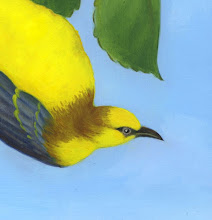
A Canadian artist living near Montreal, Lyse Marion borrows from a range of visual imagery to create lyrical and evocative digital collages. Marion is currently the manager of a small gallery near Montreal and draws upon her experience in social work and a passion for art to help create her images.
Above the Odds combines eastern and western imagery to create a mysterious, otherworldly atmosphere. The towering figure of Degas' little ballerina statue imposes itself on a Middle-eastern town. The young girl is on verge of womanhood, in a state of flux just as the Middle East struggles with it's own growing pains.
The juxtaposition of an immensely tall European girl-child into a Middle-eastern setting is enhanced by the further juxtaposition of orange and blue in the landscape. Though it is hardly unnatural to see an orange sky or a blue building, the saturation of the colors completes the atmosphere of uncertainty and vague foreboding. Yet the figure of the unselfconscious ballerina allows one to feel some sense of stability even here.
The image gently but firmly reminds us of the issue of women's rights, an often under-represented topic in the Middle East. Marion's long background in social work allows her to bring this issue to the fore with sensitivity and dignity. As the title Above the Odds implies, Marion has faith in human nature to rise above culturally imposed limitations.
Marion has much more work available to view in her Etsy shop (link provided above) and I encourage everyone to take a look.
Above the Odds combines eastern and western imagery to create a mysterious, otherworldly atmosphere. The towering figure of Degas' little ballerina statue imposes itself on a Middle-eastern town. The young girl is on verge of womanhood, in a state of flux just as the Middle East struggles with it's own growing pains.
The juxtaposition of an immensely tall European girl-child into a Middle-eastern setting is enhanced by the further juxtaposition of orange and blue in the landscape. Though it is hardly unnatural to see an orange sky or a blue building, the saturation of the colors completes the atmosphere of uncertainty and vague foreboding. Yet the figure of the unselfconscious ballerina allows one to feel some sense of stability even here.
The image gently but firmly reminds us of the issue of women's rights, an often under-represented topic in the Middle East. Marion's long background in social work allows her to bring this issue to the fore with sensitivity and dignity. As the title Above the Odds implies, Marion has faith in human nature to rise above culturally imposed limitations.
Marion has much more work available to view in her Etsy shop (link provided above) and I encourage everyone to take a look.




 In order to put up a strong front, Justinian utilized church imagery to reinforce his political position. As this mosaic shows, Justinian styled himself a representative of God. His purple robes and halo show his majesty and position as pontif-in-chief; his prominent position in the composition let's everyone know who is in charge.
In order to put up a strong front, Justinian utilized church imagery to reinforce his political position. As this mosaic shows, Justinian styled himself a representative of God. His purple robes and halo show his majesty and position as pontif-in-chief; his prominent position in the composition let's everyone know who is in charge.




